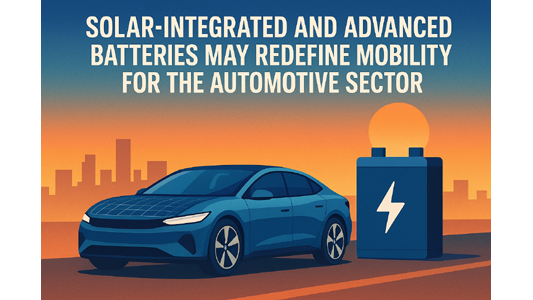Introduction
The automotive industry stands at the threshold of its most profound transformation since the invention of the internal combustion engine. With growing concerns over climate change, volatile fuel prices, and stricter emission regulations, the race is on to find sustainable alternatives to traditional mobility. Electric vehicles (EVs) have already reshaped the conversation, but the next leap forward lies in combining two powerful innovations: solar-integrated systems and advanced batteries. Together, they hold the potential to create vehicles that are not only cleaner and more efficient but also capable of generating and storing their own energy. This integration could redefine mobility—reducing dependence on fossil fuels, easing the burden on power grids, and unlocking new opportunities for sustainable transport across the globe.
Solar-Integrated Vehicles: Harnessing the Power of the Sun
Solar energy has long been hailed as a limitless resource, but its direct application in the automotive sector is only now becoming viable due to advances in photovoltaic (PV) efficiency, lightweight materials, and vehicle design.
- Supplemental Energy Generation: Solar panels embedded in car rooftops or body surfaces can charge onboard batteries while the vehicle is parked or even while driving, reducing reliance on grid charging.
- Extended Range: For electric vehicles (EVs), solar integration could provide an additional 10–20 km per day under optimal sunlight conditions—enough to cover daily commutes in many urban areas.
- Reduced Grid Stress: With millions of EVs expected to be deployed globally, solar-assisted vehicles can ease the load on national grids by partially self-powering.
Companies like Lightyear, Aptera, and Toyota have already demonstrated prototypes and production models with solar integration, signaling the feasibility of mainstream adoption.
The Role of Advanced Batteries
While solar panels can provide supplemental power, the backbone of next-generation mobility lies in advanced battery technologies. Traditional lithium-ion cells are being challenged by safer, more efficient alternatives that promise faster charging, higher energy density, and longer lifespans.
- Solid-State Batteries: Offering higher energy density and improved safety, these batteries can potentially double EV range while reducing fire hazards.
- Lithium-Sulfur and Sodium-Ion Batteries: Emerging as cost-effective, sustainable alternatives, these chemistries could decrease dependence on scarce minerals like cobalt.
- Fast-Charging Capabilities: Future batteries could recharge in under 10 minutes, making EV refueling as quick as filling a fuel tank.
Together, these innovations address two of the largest barriers to EV adoption: range anxiety and charging convenience.
A New Mobility Ecosystem
The integration of solar power and advanced batteries will not just change the mechanics of vehicles—it will reshape the entire mobility ecosystem:
- Decentralized Energy Use: Cars become energy producers, not just consumers.
- Sustainable Urban Transport: Solar-assisted EV fleets, including buses and taxis, can operate with lower running costs and reduced emissions.
- Rural Mobility: In regions with limited charging infrastructure, solar-powered vehicles can provide reliable access without depending on grid networks.
Challenges Ahead
Despite the promise, widespread adoption requires overcoming several hurdles:
- Solar efficiency is still limited, and panels add cost to vehicles.
- Advanced batteries face scalability and raw material challenges.
- Infrastructure for recycling and second-life applications must be built.
The Road Ahead
As renewable energy technologies advance, the fusion of solar integration and next-gen batteries could make vehicles truly self-sustaining. In the coming decade, cars may not just be modes of transport but mobile energy hubs—clean, efficient, and independent. This vision aligns perfectly with the global shift toward net-zero emissions, promising a future where mobility is powered as much by the sun as by innovation.
Conclusion
Solar roofs and smarter batteries aren’t just upgrades to our cars—they’re a glimpse into a new era of mobility. Imagine vehicles that sip sunlight during the day, store that energy in next-generation batteries, and carry us farther with fewer stops and less guilt about our carbon footprint. While the road to mass adoption still has bumps—cost, efficiency, and infrastructure—these innovations point toward a cleaner, more self-reliant future. The car of tomorrow won’t just move us from place to place; it will embody the perfect balance of technology, sustainability, and freedom.












